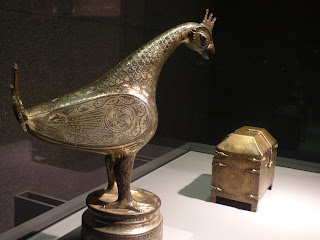First up, we arrived in 43 degree heat with 90% humidity. It was like stepping into an oven. The heat was all invasive but we were determined to see as much as we could of Qatar's capital city. So the next morning we set off very early through the city to visit the Souk Waqif, the city's oldest market.
Because of the heat there were a lot of shaded arcades in the areas we walked through on our way to the souk; I loved the elaborate lights in them.
When we arrived at the souk it was eerily quiet though a few stalls were open. We were the only ones there save for a couple of locals. We were told later that no-one visits the souk in the daytime as it's far too hot. One website (that we didn't see at the time said: The best time to visit is between 7:00 pm and 11:00 pm) Silly us! I am so cheating here with this next photo, but I want you to see what it is like at night - when we didn't go.
 |
| Source: cnn travel |
I loved the lights ...
... and the fabrics
The camel was a tempting purchase... but luckily I resisted.
The spices ... decorative as well as sweet-smelling.It was nice and cool here in this cafe but there was nothing on the menu we wanted; it was all fatty fried stuff.
We found it interesting that all the people we met this day were not originally from Qatar. We encountered a Pakistani taxi driver, two Sri Lankan hotel staff, a Nigerian pool cleaner, a Nepali taxi driver, a Ukrainian barista, an Indian waiter and a Thai airline check-in man!
The best decision we made was to get a taxi to the Museum of Islamic Art. Not only was it a beautiful building, and cool, and free, but the display of artefacts, mosaics, carpets, lights and lanterns, jewellery, swords, ceramics, glass and architectural remnants from all corners of the Islamic world dating back to the 7th century was absolutely wonderful.
We discovered that the building was designed by the same man who did the glass Pyramid outside the Louvre in Paris.
The museum sits on a hill overlooking the Persian Gulf. The entrance itself was stunning, along a palm tree-lined walkway.
The cubist building stood out in stark contrast to the blue sky and green palms.
Water is not a problem here.
The interior was stunning in its understated grandeur.
Here are some of the treasures we discovered. Each one was accompanied by a descriptive text that also gave its date and country of origin. Items came from Syria, India, China, Italy, Egypt, Spain, Iran, Turkey and Central Asia. I was overwhelmed by the beauty, detail, grace and artistry of what we saw.
 |
| Stone bracket India 15th century |
 |
| Bracelets Syria 11th century |
 |
| Casket Sicily 12th century; Fountain head Spain 10th century |
 |
| Earrings Egypt 12th century |




























No comments:
Post a Comment